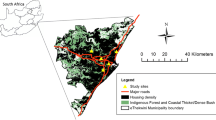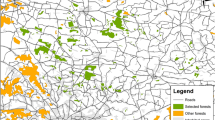Abstract
The relative contributions of habitat structure and composition to biodiversity are often scale-dependent. Although bird communities in boreal forest have been largely altered and threatened by forest harvesting, bird habitat selection in this ecosystem has not been fully understood. Our study aimed to assess the relative contributions of habitat structure and composition on the assemblages of boreal birds at multiple spatial scales characterized by radii ranging from 100 to 1,000 m. We recorded bird species occurrence at 96 stations located in an old-growth forest in the Côte-Nord region of Québec, Canada. We characterized habitat structure using the proportion of dense, open, and sparse stands, and habitat composition using the proportions of coniferous, mixedwood, and deciduous stands. We used partial canonical correspondence analyses and hierarchical variance partitioning to assess the relative contribution of habitat structure and composition on bird assemblage, and logistic regression to model the probability of occurrence for individual species in response to habitat variables. Our results revealed that habitat structure and composition explained similar proportions of the variance in bird assemblage (21.7 vs. 21.6 %), regardless of spatial scale. Whilst logistic regression yielded fair predictions in the occurrence of individual species (i.e., area under the receiver-operating characteristic curve >0.70 for 90 % of the species), it further confirmed our findings in community level analysis. Our study indicates that habitat structure and composition are both important in shaping bird assemblages, but spatial scale draws little influence on their relative contributions.



Similar content being viewed by others
References
Anderson DP, Forester JD, Turner MG et al (2005) Factors influencing female home range sizes in elk (Cervus elaphus) in North American landscapes. Landsc Ecol 20:257–271
Azeria ET, Fortin D, Hébert C et al (2009a) Using null model analysis of species co-occurrences to deconstruct biodiversity patterns and select indicator species. Divers Distrib 15:958–971
Azeria ET, Fortin D, Lemaître J et al (2009b) Fine-scale structure and cross-taxon congruence of bird and beetle assemblages in an old-growth boreal forest mosaic. Glob Ecol Biogeogr 18:333–345
Babin JS, Fortin D, Wilmshurst JF et al (2011) Energy gains predict the distribution of plains bison across populations and ecosystems. Ecology 92:240–252
Barrow WC Jr, Chao-Chieh C, Hamilton RB et al (2000) Disruption and restoration of en route habitat, a case study: the chenier plain. Stud Avian Biol 20:71–87
Bersier LF, Meyer DR (1994) Bird assemblages in mosaic forests: the relative importance of vegetation structure and floristic composition along the successional gradient. Acta Oecologica 15:561–576
Boonman AM, Boonman M, Bretschneider F et al (1998) Prey detection in trawling insectivorous bats: duckweed affects hunting behavior in Daubenton’s bat, Myotis daubentonii. Behav Ecol Sociobiol 44:99–107
Borcard D, Legendre P, Drapeau P (1992) Partialling out the spatial component of ecological variation. Ecology 73:1045–1055
Boscolo D, Metzger JP (2009) Is bird incidence in Atlantic forest fragments influenced by landscape patterns at multiple scales? Landsc Ecol 24:907–918
Bouchard M, Pothier D, Gauthier S (2008) Fire return intervals and tree species succession in the North Shore region of eastern Quebec. Can J For Res 38:1621–1633
Boucher D, De Grandpré L, Gauthier S (2003) Développement d’un outil de classification de la structure des peuplements et comparaison de deux territoires de la pessière à mousses du Québec. Forestry Chronicel 79:318–328
Boyce MS (2006) Scale for resource selection functions. Divers Distrib 121:269–276
Crête M, Drolet B, Huot J et al (1995) Postfire sequence of emerging diversity among mammals and birds in the north of the boreal forest in Quebec. Can J For Res 25:1509–1518
Cushman SA, McGarigal K (2002) Hierarchical, multi-scale decomposition of species-environment relationships. Landsc Ecol 17:637–646
Deppe JL, Rotenberry JT (2008) Scale-dependent habitat use by fall migratory birds: vegetation structure, floristics, and geography. Ecol Monogr 78:461–487
Drapeau P, Leduc A, Giroux JF et al (2000) Landscape-scale disturbances and changes in bird communities of boreal mixed-wood forests. Ecol Monogr 70:423–444
Edenius L, Sjöberg K (1997) Distribution of birds in natural landscape mosaics of old-growth forests in northern Sweden: relations to habitat area and landscape context. Ecography 20:425–431
Fleishman E, Mcdonal N, Mac Nally R et al (2003) Effects of floristics, physiognomy and non-native vegetation on riparian bird communities in a Mojave Desert watershed. J Anim Ecol 72:484–490
Fleishman E, Noss RF, Noon BR (2006) Utility and limitations of species richness metrics for conservation planning. Ecol Ind 6:543–553
Fortin D, Fryxell JM, O’Brodovich L, Frandsen D (2003) Foraging ecology of bison at the landscape and plant community levels: the applicability of energy maximization principles. Oecologia 134:219–227
Fuhlendorf SD, Harrell WC, Engle DM et al (2006) Should heterogeneity be the basis for conservation? Grassland bird response to fire and grazing. Ecol Appl 16:1706–1716
Garden JG, Mcalpine CA, Possingham HP et al (2007) Habitat structure is more important than vegetation composition for local-level management of native terrestrial reptile and small mammal species living in urban remnants: a case study from Brisbane, Australia. Austral Ecol 32:669–685
George TL, Zack S (2001) Spatial and temporal considerations in restoring habitat for wildlife. Restor Ecol 9:272–279
Gotelli NJ, Colwell RK (2001) Quantifying biodiversity: procedures and pitfalls in the measurement and comparison of species richness. Ecol Lett 4:379–391
Grand J, Cushman SA (2003) A multi-scale analysis of species-environment relationships: breeding birds in a pitch pine-scrub oak (Pinus rigida-Quercus ilicifolia) community. Biol Conserv 112:307–317
Hobson KA, Kirk DA, Smith AR (2000) A multivariate analysis of breeding bird species of western and central canadian boreal forests: stand and spatial effects. Ecoscience 71:267–280
Holmes RT, Robinson SK (1981) Tree species preferences of foraging insectivorous birds in a northern hardwoods forest. Oecologia 481:31–35
Hosmer DW, Lemeshow S (2000) Applied Logistic Regression. Wiley, New York
Huston MA (1994) Biological diversity: the coexistence of species on changing landscapes. Cambridge University Press, Cambridge
Imbeau L, Savard JPL, Gagnon R (1999) Comparing bird assemblages in successional black spruce stands originating from fire and logging. Can J Zoolog 77:1850–1860
Imbeau L, Mönkkönen M, Desrochers A (2001) Long-term effects of forestry on birds of the eastern Canadian boreal forests: a comparison with Fennoscandia. Conserv Biol 15:1151–1162
Janssen P, Fortin D, Hébert C (2009) Beetle diversity in a matrix of old-growth boreal forest: influence of habitat heterogeneity at multiple scales. Ecography 32:423–432
Lee PY, Rotenberry JT (2005) Relationships between bird species and tree species assemblages in forested habitats of eastern North America. J Biogeogr 32:1139–1150
Lichstein JW, Simons TR, Franzreb KE (2002) Landscape effects on breeding songbird abundance in managed forests. Ecol Appl 12:836–857
Mac Nally RC (1990) The roles of floristics and physiognomy in avian community composition. Aust J Ecol 15:321–327
McElhinny C, Gibbons P, Brack C et al (2005) Forest and woodland stand structural complexity: its definition and measurement. For Ecol Manage 218:1–24
Moore FR, Woodrey MS, Buler JJ et al (2005) Understanding the stopover of migratory birds: a scale dependent approach. In: Ralph CJ, Rich TD (ed) Bird conservation implementation and integration in the Americas. Proceedings of the third international partners in flight conference. USDA Forest Service General Technical Report PSW-191. Pacific Southwest Research Station, Albany, California, USA, pp 684–689
Nams VO, Mowat G, Panian MA (2006) Determining the spatial scale for conservation purposes—an example with grizzly bears. Biol Conserv 128:109–119
Parrish JD, Braun DP, Unnasch RS (2003) Are we conserving what we say we are? Measuring ecological integrity within protected areas. Bioscience 53:851–860
Pham AT, de Grandpré L, Gauthier S, Bergeron Y (2004) Gap dynamics and replacement patterns in gaps of the northeastern boreal forest of Québec. Can J For Res 34:353–364
Prendergast JR, Quinn RM, Lawton JH et al (1993) Rare species, the coincidence of diversity hotspots and conservation strategies. Nature 365:335–337
Preston MI, Harestad AS (2007) Community and species responses by birds to group retention in a coastal temperate forest on Vancouver Island, British Columbia. For Ecol Manage 243:156–167
Robinson SK, Holmes RT (1984) Effects of plant-species and foliage structure on the foraging behavior of forest birds. Auk 101:672–684
Rosenzweig ML (1995) Species diversity in space and time. Cambridge University Press, Cambridge
Rotenberry JT (1985) The role of habitat in avian community composition: physiognomy or floristics. Oecologia 67:213–217
Schmiegelow FKA, Mönkkönen M (2002) Habitat loss and fragmentation in dynamic landscapes: avian perspectives from the boreal forest. Ecol Appl 12:375–389
Simon NPP, Diamond AW, Schwab FE (2003) Do northern forest bird communities show more ecological plasticity than southern forest bird communities in eastern Canada? Ecoscience 10:289–296
Smith AC, Koper N, Francis CM et al (2009) Confronting collinearity: comparing methods for disentangling the effects of habitat loss and fragmentation. Landsc Ecol 24:1271–1285
ter Braak CJF (1986) Canonical correspondence analysis: a new eigenvector technique for multivariate direct gradient analysis. Ecology 67:1167–1179
Tews J, Brose U, Grimm V et al (2004) Animal species diversity driven by habitat heterogeneity/diversity: the importance of keystone structures. J Biogeogr 31:79–92
Tischendorf L (2001) Can landscape indices predict ecological processes consistently? Landsc Ecol 16:235–254
Vanhooydonck B, Van Damme R, Aerts P (2000) Ecomorphological correlates of habitat partitioning in Corsican lacertid lizards. Funct Ecol 14:358–368
Verner J (1988) Optimizing the duration of point counts for monitoring trends in bird populations. USDA Forest Service, Berkeley
Villard MA, Trzcinski MK, Merriam G (1999) Fragmentation effects on forest birds: relative influence of woodland cover and configuration on landscape occupancy. Conserv Biol 13:774–783
Virkkala R, Rajasärkkä A (2006) Spatial variation of bird species in landscapes dominated by old-growth forests in northern boreal Finland. Biodivers Conserv 15:2143–2162
Virolainen KM, Ahlroth P, Hyvärinen E et al (2000) Hot spots, indicator taxa, complementarity and optimal networks of taiga. Proc R Soc Lond Ser B Biol Sci 267:1143–1147
Vitousek PM, Mooney HA, Lubchenco J et al (1997) Human domination of earth’s ecosystems. Science 277:494–499
Wiens JA (1989) Spatial scaling in ecology. Funct Ecol 3:385–397
Wiens JA, Rotenberry JT (1981) Habitat associations and community structure of birds in shrubsteppe environments. Ecol Monogr 51:21–41
Acknowledgments
We thank our field assistants: E. Bilodeau, A. Bourke, M. Bouthillette, S. Brugerolle, G. Côté, C. Laberge-Pelletier, F. Lavoie, and I. Plante. We are grateful to E. Azeria, S. Courant, M.-L. Le Blanc, W. F. J. Parsons, and G. Rompré for useful comments on an earlier version of the manuscript. This research was founded by the NSERC–Université Laval Industrial Research Chair in Silviculture and Wildlife, the Canada Foundation for Innovation, and the Fond Québécois de la Recherche sur la Nature et les Technologies. We thank our numerous industrial partners who facilitated field work and provided access to management areas: M. St-Onge (Kruger), C. Warren, C. Gauthier, and J.-F. Gauthier (Abitibi Consolidated), and D. Gagnon (Bowater).
Author information
Authors and Affiliations
Corresponding author
Rights and permissions
About this article
Cite this article
Lemaître, J., Darveau, M., Zhao, Q. et al. Multiscale assessment of the influence of habitat structure and composition on bird assemblages in boreal forest. Biodivers Conserv 21, 3355–3368 (2012). https://doi.org/10.1007/s10531-012-0366-3
Received:
Accepted:
Published:
Issue Date:
DOI: https://doi.org/10.1007/s10531-012-0366-3




